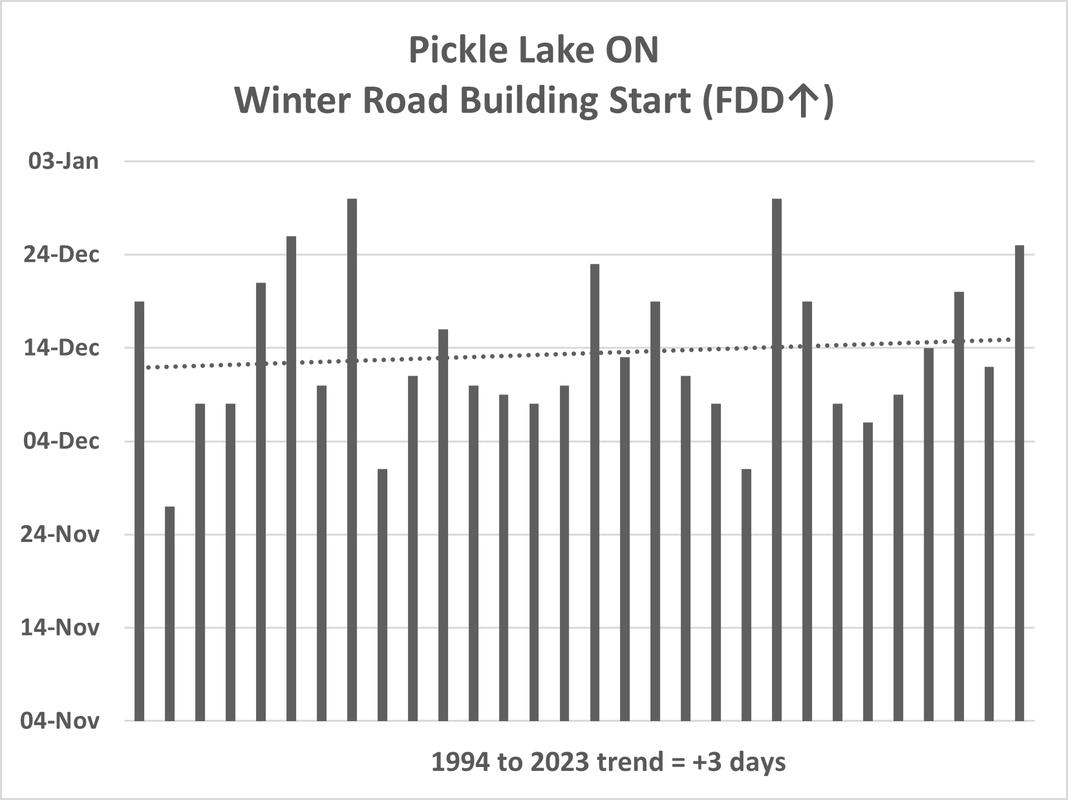|
The Nishnawbe Aski Nation (NAN) consists of 49 member First Nations, 30 of which are in remote Northern Ontario locations and dependent upon the construction of temporary winter roads for supply delivery. On February 9th a press release titled Chiefs Declare Winter Road State of Emergency as Warm Weather Threatens Vital Shipments included: “The winter road season should be well underway, but temperatures remain unseasonably warm, making them extremely dangerous and unsafe to use. This poses severe safety risks to community members and commercial drivers who are risking their lives for necessary travel,” said Grand Chief Alvin Fiddler. “Our communities rely on these roads for delivering essential goods and our leaders are understandably concerned. We will begin discussions with our federal and provincial Treaty partners immediately to ensure that sufficient freight and road repair subsidies are provided to NAN communities so air transport can be arranged as quickly as possible.” A February 11th Global News story followed, explaining that Impassable winter roads create 'dire' situations for Ontario First Nations. The Grand Chief was interviewed: Fiddler said the conditions are the latest example of how climate change, which threatens to make the winter season increasingly shorter and unpredictable, disproportionately impacts First Nations. Along with subsidies to cover the immediate cost of air transport in the short-term, NAN also want long-term solutions like airport expansions or a permanent highway network to be built. Such projects would obviously be incredibly expensive. Is the season for winter road access doomed due to Global Warming as Grand Chief Fiddler suggests? It has to get consistently frigid to allow construction of ice roads, primarily because of the many lakes that must be traversed in the Northern Ontario region. A report by Climatedata.ca, Winter Ice Roads in Northern Ontario, explains that there needs to be an accumulation of 380 Freezing Degree Days (FDD) before it is safe to begin construction every year: Freezing Degree Days (FDDs) begin to accumulate when the daily mean temperature drops a certain threshold (commonly 0°C). If a day’s mean temperature is -21°C. for example, it increases the annual FDD value by 21. Climatedata.ca found that the 380 FDD pre-build minimum historically is reached before December 31 each year, but their computer models warn: However, the preconditioning period may shift into January as the climate warms, and the spring melt period will also start earlier than in the past. How have things been trending up to this point in time? Not far from the NAN-member Eabametoong First Nation mentioned in the Global News piece, is a long-running weather station at Pickle Lake, Ontario. The actual climate data from the last 30 years at that location shows the 380 FDD threshold date has indeed been trending later by about 3 days: However, the start date for winter road construction is not the whole picture. How long the frozen conditions persist is arguably more important. The point where FDD stops accumulating and positive mean temperatures take over, is a good measure for the start of the spring melt: As shown, the 30 year trend for the end of FDD accumulation and start of thawing is also later, by about 7 days. From this, and contrary to the Climate Change narrative, the usable life of a winter road in the Pickle Lake area of Northern Ontario is on average getting longer.
There is no doubt this winter has been warmer than usual. Pickle Lake did not get to 380 FDD until December 25, which was the 4th latest winter road building start date in the last 30 years. For interest though, Christmas Day was also the 380 FDD point for Pickle Lake back in 1939. It may be reasonable for NAN to declare a short emergency and request subsidies for their 30 remote communities because of recent weather. However, to suggest that Climate Change is causing the overall demise of winter roads, just isn’t supported by the data. According to Environment Canada mean temperatures at Pickle Lake are now back to normal, around minus 18C. This should allow winter road shipments to commence or resume, ending the emergency. However, negotiations concerning Nishnawbe Aski Nation transportation access will likely never conclude.
0 Comments
Leave a Reply. |
Hot Topics
Aboriginal Title Almost Record Heat Atmospheric Rivers Attribution Simulation Carbon Capture Child Litigation Climate Shift Index CO2 Offset Leakage Coastal Flood Risk Democracy Lost Drought Exaggeration Eco-Negativity Eco-Politics ESC Investment Evolution Excess Hydro Expert Hypocrisy Extreme Heatwaves Fake Hype Geo-Engineering Government Bias Heat Waves Hottest Month Ever Hottest Year Ever Housing Crisis Hyperthermia Ice Roads Indigenous Conservation Indoctrination Kelp Farms Landslides Media Bias Mental Illness Misplaced Reconcilliation Misleading Data National Discord Natural Gas Net-Zero Future Outside Play Park Take-Over Political Deception Public Safety Impasse Sea Level Ruse Socialist Agenda Solar Panels Species Not At Risk Statistical Dishonesty Sue Big Oil Temperature Trickery Treaty Infringment Tsunami Refuge Unmarked Burials Unprecedented Drought Urban Heat Island Very Hot Days Warming Causes Cold Water Supply White Dislike Wildfire Wildlife Death Woke Plans Worsening Storms |


